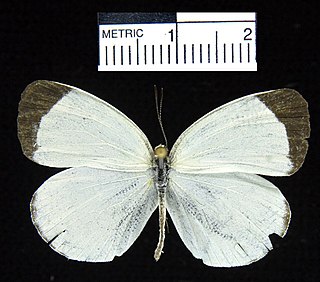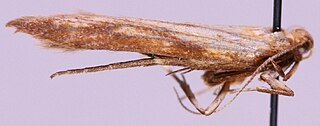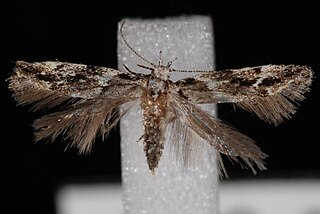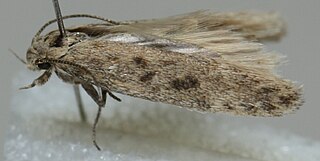
Robinia is a genus of flowering plants in the family Fabaceae, tribe Robinieae, native to North America. Commonly known as locusts, they are deciduous trees and shrubs growing 4–25 metres (13–82 ft) tall. The leaves are pinnate with 7–21 oval leaflets. The flowers are white or pink, in usually pendulous racemes. Many species have thorny shoots, and several have sticky hairs on the shoots.

The Gelechiidae are a family of moths commonly referred to as twirler moths or gelechiid moths. They are the namesake family of the huge and little-studied superfamily Gelechioidea, and the family's taxonomy has been subject to considerable dispute. These are generally very small moths with narrow, fringed wings. The larvae of most species feed internally on various parts of their host plants, sometimes causing galls. Douglas-fir (Pseudotsuga) is a host plant common to many species of the family, particularly of the genus Chionodes, which as a result is more diverse in North America than usual for Gelechioidea.

Aroga is a genus of moths in the family Gelechiidae.

Deltophora is a genus of moths in the family Gelechiidae. The genus was originally described from South Africa and based on a taxonomic revision contains about 20 species on all continents except Antarctica. Host plants of larvae and adults are only known for two Chinese species of Deltophora.
Sinoe is a genus of moth in the family Gelechiidae.

Macrosaccus robiniella is a moth of the family Gracillariidae.

Parectopa robiniella, the locust digitate leafminer, is a moth of the family Gracillariidae. It is native to North America, but was accidentally introduced to Italy, where it was first found in 1970. It has now been recorded from Italy, France, Germany, Slovenia, Croatia, Austria, Serbia, Slovakia, Romania, Ukraine and Hungary.

Eurema albula, the ghost yellow, is a butterfly in the family Pieridae. It is found from southern Texas south through the West Indies and mainland tropical Central and South America to Brazil. The habitat consists of tropical forests and second growth.

Dichomeridinae is a subfamily of moths in the family Gelechiidae.

Caryocolum amaurella is a moth of the family Gelechiidae. It is found in Denmark, Fennoscandia, Germany, Austria, Switzerland, Italy, Estonia, Latvia, the Czech Republic, Slovakia, former Yugoslavia, Hungary, Greece, Ukraine and Russia. It is also present in Turkey. The species is restricted to warm and sunny habitats such as dry meadows and pastures from lowland localities to about 2,200 meters in the Alps.

Metzneria neuropterella, the brown-veined neb, is a moth of the family Gelechiidae. It is found from most of Europe to the southern Ural Mountains, the Caucasus, southern and south-eastern Siberia and Mongolia, as well as in North Africa. The habitat consist of short-turfed, herb rich chalk downland.

Metzneria lappella, the burdock seedhead moth or burdock seed moth, is a moth of the family Gelechiidae.

Recurvaria nanella, the lesser bud moth, is a moth of the family Gelechiidae. It is widely distributed in Europe and is also found in Turkey, the Near East, North Africa, the Caucasus, Transcaucasia, Kazakhstan and south-eastern Siberia. It is also found in North America, where it is probably introduced.

Scrobipalpa obsoletella, the summer groundling, is a moth of the family Gelechiidae. It is found in most of Europe, Turkey, the Caucasus, from Iran to Asian Russia (Transbaikal) and Mongolia. It has also been recorded from New Zealand, South Africa and North America, where it is probably an introduced species. The habitat consists of coastal salt marshes and sandy beaches.

Gelechiinae is a subfamily of moths in the family Gelechiidae. It was described by Henry Tibbats Stainton in 1854.

Aroga compositella, the six-spotted aroga moth, is a moth of the family Gelechiidae. It is found in the United States, where it has been recorded from Alabama, Colorado, Florida, Georgia, Louisiana, Maine, Massachusetts, Mississippi, New Hampshire, North Carolina, Oklahoma, South Carolina, Tennessee, Texas and Wisconsin.
Sinoe capsana is a moth of the family Gelechiidae. It is found in North America, where it has been recorded from southern Florida.

Sinoe chambersi is a moth of the family Gelechiidae. It is found in North America, where it has been recorded from the United States and from Canada.
Sinoe kwakae is a moth of the family Gelechiidae. It is found in North America, where it has been recorded from Louisiana to Florida.

Filatima pseudacaciella, the dusky-backed filatima moth, is a moth of the family Gelechiidae. It is found in North America, where it has been recorded from California, Illinois, Indiana, Kansas, Kentucky, Louisiana, Maine, Massachusetts, Mississippi, New Hampshire, New York, Ohio, Oklahoma, Ontario, Tennessee and West Virginia.














